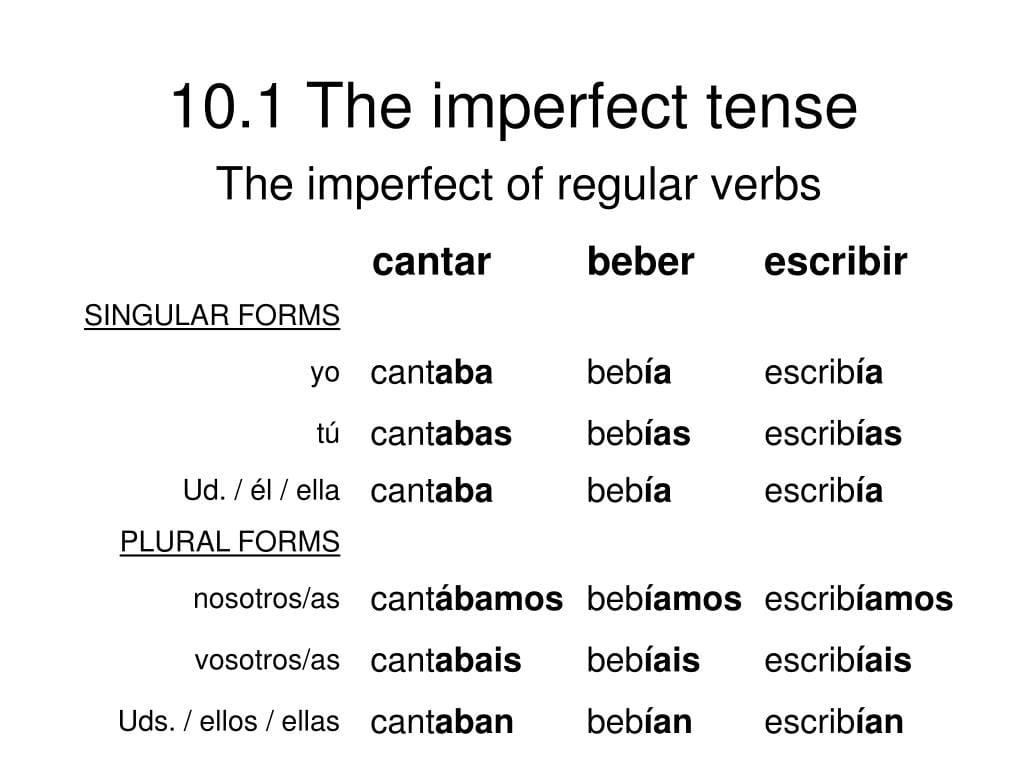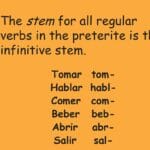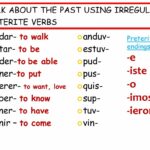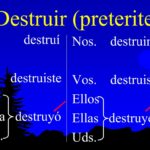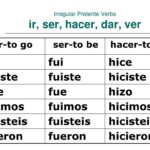This guide provides a clear, step-by-step approach to mastering the Spanish imperfect tense. We’ll cover how to form it, when to use it, common mistakes to avoid, and provide practical examples to solidify your understanding. Let’s transform this tense into your next Spanish superpower!
Unveiling the Storyteller: The Spanish Imperfect
The Spanish imperfect tense is less a grammatical fortress and more a friendly storyteller, enriching your narratives of the past. Unlike the preterite tense, which focuses on completed actions, the imperfect tense illuminates ongoing actions, habitual practices, and descriptive details. It’s the key to setting the scene and providing context to your Spanish stories. Could tener imperfect conjugation be an efficient way to get results?
Conjugating Regular Verbs: A Simple Recipe
Mastering regular verbs in the imperfect tense is remarkably straightforward. Take the infinitive (e.g., hablar, comer, vivir), remove the ending (-ar, -er, or -ir), and add the corresponding imperfect ending.
- -ar verbs: -aba, -abas, -aba, -ábamos, -abais, -aban (e.g., hablar becomes hablaba, hablabas, hablaba, etc.)
- -er and -ir verbs: -ía, -ías, -ía, -íamos, -íais, -ían (e.g., comer becomes comía, comías, comía, etc.; vivir becomes vivía, vivías, vivía, etc.)
With a little practice, you’ll be conjugating these verbs effortlessly.
Conjugating Irregular Verbs: The Trio
Spanish, like any language, has its rule-breakers. The imperfect tense has three irregular verbs: ir (to go), ser (to be), and ver (to see). Fortunately, there are only three to memorize!
| Verb | Yo | Tú | Él/Ella/Usted | Nosotros | Vosotros | Ellos/Ellas/Ustedes |
|---|---|---|---|---|---|---|
| Ir | iba | ibas | iba | íbamos | ibais | iban |
| Ser | era | eras | era | éramos | erais | eran |
| Ver | veía | veías | veía | veíamos | veíais | veían |
Using the Imperfect Tense: Painting the Past
The imperfect tense is your artistic tool for creating atmosphere and describing ongoing actions or states in the past. Here’s when it shines:
Habitual Actions: “Cuando era niño, jugaba al fútbol todos los días.” (When I was a child, I used to play football every day.)
Descriptions: “Tenía veinte años y vivía en Madrid. Siempre hacía frío en invierno.” (I was twenty years old and I lived in Madrid. It was always cold in winter.)
Emotional States: “Estaba muy nervioso antes del examen.” (I was very nervous before the exam.)
Simultaneous Actions: “Leía un libro mientras llovía.” (I was reading a book while it was raining.)
Background Information: Often used with the preterite, the imperfect sets the stage: “Mientras yo leía un libro (imperfect), sonó el teléfono (preterite).” (While I was reading a book, the phone rang.)
Mastering the Nuances: Tips and Tricks
The imperfect tense emphasizes the ongoing nature of past actions, unlike the preterite, which captures completed actions. When you look at tomar preterite, it’s clear there are many options. Ongoing research suggests that differentiating between the imperfect and preterite can be challenging. Immersion and practice are key to developing an intuitive understanding of their nuances. Some experts believe that focused study on contextual usage can greatly accelerate this process. However, there’s no one-size-fits-all approach. Remember, language evolves, and some usage rules may be more flexible than traditionally taught.
Forming the Imperfect Tense: A Step-by-Step Guide
Identify the Infinitive: Locate the verb’s infinitive form (e.g., hablar, comer, vivir).
Remove the Ending: Discard the infinitive ending (-ar, -er, -ir).
Add the Imperfect Ending: Attach the appropriate ending based on the subject and verb type (regular or irregular). See the tables above for the endings.
Five Key Uses of the Imperfect Tense
Ongoing Actions: Describing actions in progress (e.g., “Estaba comiendo.” – I was eating.)
Habitual Actions: Describing repeated actions in the past (e.g., “Siempre jugaba al tenis.” – I always used to play tennis.)
Descriptions: Describing past characteristics or conditions (e.g., “La casa era azul.” – The house was blue.)
Time and Age: Indicating time or age in the past (e.g., “Eran las tres.” – It was three o’clock. / “Tenía cinco años.” – I was five years old.)
Background Information: Setting the context for other past events, often used with the preterite (e.g., “Mientras caminaba, vi un pájaro.” – While I was walking, I saw a bird.)
When to Use the Imperfect Tense: Common Scenarios
The imperfect tense is your tool for describing the “what it was like” aspect of the past:
Ongoing Actions: “El sol brillaba.” (The sun was shining.)
Habitual Actions: “De niño, jugaba al fútbol todos los sábados.” (As a child, I used to play soccer every Saturday.)
Physical/Emotional States: “Estaba feliz.” (I was happy.) / “Tenía miedo.” (I was afraid.)
Setting the Scene: “Era una noche oscura y tormentosa.” (It was a dark and stormy night.)
Age and Time: “Tenía diez años.” (I was ten years old.) / “Eran las siete de la mañana.” (It was seven in the morning.)
Simultaneous Actions: “Mientras cocinaba, escuchaba música.” (While I was cooking, I was listening to music.)
Remember, language is nuanced. Some linguists suggest that the imperfect can convey a sense of incompletion or uncertainty. Regional variations also exist. Don’t be discouraged if mastering this tense takes time. Continued practice and exposure to authentic Spanish will refine your understanding.
- Unlock Filipino Culture: A Deep Dive into Traditions and Practices - April 23, 2025
- Unlock Spanish Culture: Insights & Opportunities Now - April 23, 2025
- White Spirit Uses & Substitutes: A Deep Dive for Pros & DIYers - April 23, 2025
